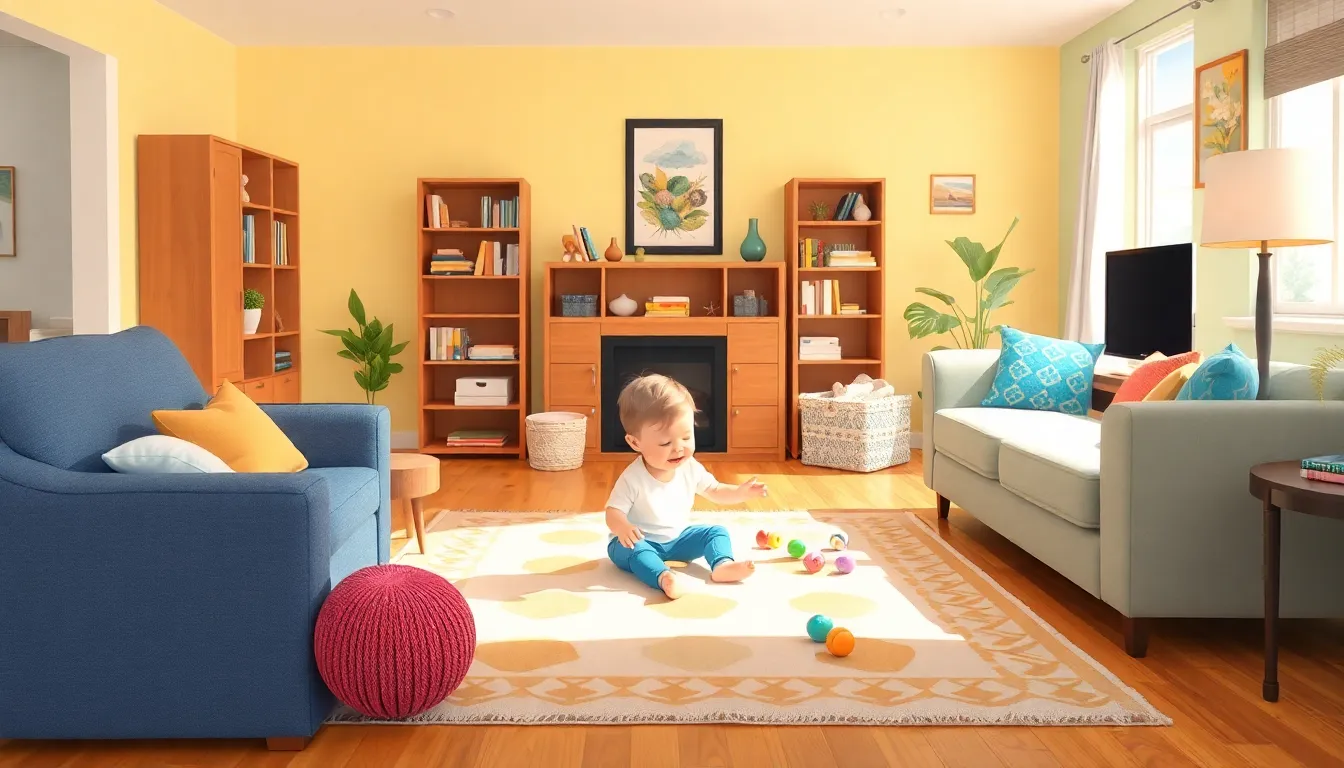When it comes to keeping kids safe at home, it’s not just about baby-proofing the corners and hiding the sharp objects. It’s a full-on adventure! Imagine a world where your home is a fortress, and your little explorers are equipped with safety gear—think of it as a superhero training camp, minus the capes and questionable spandex.
Table of Contents
ToggleImportance of Home Safety for Kids
Safety in the home plays a crucial role in children’s well-being. Creating a secure environment allows kids to explore their surroundings without unnecessary risks. Parents must recognize that their homes can act as safe havens when properly equipped. Childproofing measures, such as securing furniture and installing safety gates, serve to minimize accidents and injuries.
Statistics highlight that unintentional injuries cause significant harm to children under 14 years old. The Centers for Disease Control and Prevention reports that these injuries are the leading cause of death in this age group. By addressing potential hazards, families can drastically reduce these statistics and promote a safer living space.
Attention should also be given to emergency preparedness. Establishing clear evacuation plans and practicing them enhances children’s understanding of safety protocols. When children know what to do during emergencies, their response becomes quicker and more effective.
Understanding safety goes beyond physical precautions. Teaching children about safety also involves educating them on identifying dangerous situations. Conversations about not opening doors to strangers, for example, help reinforce personal safety skills. Moreover, engaging kids in discussions about fire and water safety equips them with knowledge necessary to handle real-life scenarios.
Encouraging open dialogues about safety helps children express concerns and curiosities. When families prioritize safety as a collective responsibility, it fosters an environment in which kids feel secure and confident. Fostering this atmosphere ensures children develop resilience while learning the importance of vigilance.
Key Areas of Home Safety

Several areas in the home require special attention to ensure safety for children. Each space holds unique risks and safety protocols.
Living Room Safety
In the living room, secure heavy furniture, like bookshelves or entertainment centers, to the walls to prevent tipping. Keep small items, such as remote controls and batteries, out of reach to reduce choking hazards. Use corner guards to soften sharp edges on tables. Maintain clear pathways to avoid tripping over toys or furniture. Ensure electrical outlets have safety covers. Regularly check that cords from electronics are tucked away to prevent accidents.
Kitchen Safety
The kitchen presents various hazards, making safety measures essential. Store sharp utensils and knives in locked drawers or cabinets. Use stove knob covers to prevent children from accidentally turning on burners. Keep cleaning supplies stored in high cabinets, securely out of reach. Utilize safety latches on cabinets to prevent access to harmful substances like detergents. Always supervise children when cooking. Consider using oven locks to deter curious hands from opening hot ovens.
Bathroom Safety
Bathroom safety involves specific precautions to prevent accidents in a wet environment. Install non-slip mats in and around the tub to minimize slipping. Use faucet covers to safeguard against burns from hot water. Keep medications and toiletries in high cabinets, secured away from children’s reach. Always supervise young children during bath time. Equip the tub with a bath seat or inflatable tub for added stability. Keep electrical devices away from water sources to avoid shock hazards.
Bedroom Safety
In the bedroom, create a safe sleeping area by using firm mattresses and eliminating soft bedding for infants. Install window guards or locks to prevent falls from heights. Keep heavy objects, such as bookshelves, anchored to walls. Select child-safe furniture without sharp edges or corners. Avoid clutter on the floor to reduce tripping risks. Educate children about the importance of maintaining a tidy space. Use night lights to provide comfort while promoting visibility during nighttime bathroom visits.
Outdoor Safety
Outdoor safety encompasses several considerations for children playing outside. Establish boundaries for play areas to prevent wandering into unsafe zones like streets. Always supervise children during play, particularly around swimming pools or near busy roads. Use helmets for biking or riding scooters to prevent head injuries. Keep outdoor equipment, such as swings and slides, in good condition. Create a safety checklist and review safe play behavior regularly. Encourage children to play in groups rather than alone for added security.
Tips for Parents
Creating a safe home for children requires proactive measures. Parents can take specific steps to empower kids with vital safety knowledge and utilize safety devices effectively.
Educating Kids About Safety
Encouraging children to recognize dangerous situations starts early. Parents should discuss potential hazards like sharp objects and electrical outlets. Frequent conversations about safety help kids understand risks they face daily. Role-playing different scenarios enhances their ability to respond correctly. Teaching about fire safety includes identifying exits and practicing evacuation drills. During discussions, it’s essential to promote confidence in asking questions. Engaging children in safety topics creates awareness and preparedness, helping them feel secure in their environment.
Using Safety Devices
Implementing safety devices significantly reduces accident risks. Installing outlet covers prevents children from tampering with electrical sockets. Locking mechanisms on cabinets keep harmful substances out of reach. Securing heavy furniture with anti-tip straps eliminates the chance of tipping during play. Additionally, using corner guards on furniture decreases the likelihood of injury from sharp edges. Monitoring smoke and carbon monoxide detectors ensures they are functional. By utilizing these devices, parents create a proactive safety net, significantly enhancing overall home security for their children.
Creating a Safety Plan
Creating a safety plan equips families to manage emergencies effectively. Start by identifying escape routes from each room, ensuring children understand multiple exits. Establish a designated meeting point outside the home, allowing kids to know where to go during an emergency.
Involve children in practice drills regularly. Frequent drills enhance familiarity with procedures and reduce anxiety during real situations. Make these exercises fun to increase engagement and retention.
Additionally, prepare a first-aid kit. Stock it with essential items like band-aids, antiseptic wipes, and emergency contact information. Keep the kit in an accessible location, and explain its purpose to children, encouraging them to seek it in case of minor injuries.
Consider holding safety discussions with children. Discuss potential dangers they might encounter, such as fire or severe weather. Reinforce understanding through age-appropriate explanations, ensuring they grasp the seriousness of each situation.
Establish communication plans, too. Ensure children memorize important phone numbers, including family, friends, and emergency services. Regularly review these numbers to keep information fresh in their minds.
Lastly, emphasize the importance of staying calm. Teach kids strategies for managing anxiety under pressure. Role-play different scenarios, allowing them to practice remaining calm and following safety protocols.
By implementing these strategies, families create a comprehensive safety plan, enhancing home safety for kids and fostering a sense of security.
Creating a safe home for children is essential for their growth and development. By implementing effective safety measures parents can transform their living spaces into secure environments where kids can explore freely. Prioritizing childproofing and emergency preparedness not only minimizes risks but also empowers children with vital safety knowledge.
Engaging kids in conversations about safety and practicing emergency drills fosters resilience and vigilance. Families that work together to establish safety protocols create a sense of security that allows children to thrive. With the right precautions in place parents can ensure their homes serve as safe havens, nurturing confident and aware individuals.



